Popular categories
Looking for a yarn?
Elven Dance
DROPS cape with hood in ”Vienna” eller "Melody". Size M.
Size: M
Materials:
DROPS VIENNA from Garnstudio
500 g colour no 19, grey
Or use:
DROPS MELODY from Garnstudio
350 g colour no 05, black
DROPS circular needle (80 cm) size 7 mm –
or size needed to get 13 sts x 15 rows in stocking st = 10 x 10 cm.
DROPS buffalo horn button, no 536: 6 pcs.
-------------------------------------------------------
Alternative Yarn – See how to change yarns here
Yarn Groups A to F – Use the same pattern and change the yarn here
Yarn usage using an alternative yarn – Use our yarn converter here
-------------------------------------------------------
- English (UK/cm)
- Česky - not translated
- Dansk
- Deutsch
- Eesti keel
- English (US/in)
- Español
- Français
- Íslenska - not translated
- Italiano - not translated
- Magyar
- Nederlands
- Norsk
- Polski - not translated
- Português
- Suomi
- Svenska
- English (UK/cm), Bulgaria
- English (UK/cm), Croatia
- English (UK/cm), Greece
- English (UK/cm), Latvia
- English (UK/cm), Lithuania
- English (UK/cm), Romania
- English (UK/cm), Slovenia
- Česky, Slovakia - not translated
Pattern instructions
Decreasing tip: Dec 4 sts each side by dec 4 sts evenly on sts worked in Garter st pattern. Dec on rows from RS.
Garter st pattern:
Row 1: K from RS
Row 2: P from WS
Row 3: K from RS
Row 4: P from WS
Row 5: P from RS
Row 6: K from WS
Repeat row 1 to 6.
Double moss st:
Row 1: * K2, P2 *, repeat from *-* and finish with K2.
Row 2: K over K and P over P.
Row 3: P over K and K over P.
Row 4: K over K and P over P.
Repeat row 3 and 4.
Buttonholes: Cast off for buttonholes on right front piece. 1 buttonhole = cast off 3rd front band st from mid front and cast on 1 new st on return row.
Cast off for buttonholes when piece measures (measured from the first MT):
34, 43, 52, 61, 70 and 79 cm.
Cape: Worked back and forth on circular needle from mid front. Cast on 325 sts (includes 6 front band sts each side towards mid front) on circular needle size 7 mm with Vienna or Melody. K 2 rows. Continue in stocking st with 6 front band sts each side in garter st. Remember the knitting tension! When piece measures 6 cm work next row as follows from RS: 6 front band sts in garter st, * K1, K2 tog *, repeat from *-* until 7 sts remain, K1, 6 front band sts in garter st = 221 sts.
K 1 row from WS. Insert a Marking Thread (MT) and now measure piece from here. K 1 row from RS, at the same time dec 1 st after the 6 front band sts = 220 m. K from row from WS. Continue as follows from RS: 6 front band sts in garter st, K2, * P4, K2 *, repeat from *-* on the next 30 sts, Garter st pattern – see above - on the next 41 sts, K2, repeat from *-* on the next 60 sts, Garter st pattern on the next 41 sts, K2, repeat from *-* on the next 30 sts and finish with 6 front band sts in garter st.
At the same time when piece measures 10 cm from MT dec 4 sts each side – see Decreasing tip! Repeat the dec on every 7 cm a total of 6 times.
At the same time when piece measures 27 cm from MT (after 3 dec = 196 sts on row) continue as follows from RS: 6 front band sts in garter st, K2, * P4, K2 *, repeat from *-* on the next 30 sts, 6 garter sts, Garter st pattern on the next 23 sts, K2, repeat from *-* on the next 60 sts, Garter st pattern on the next 23 sts, 6 garter sts, K2, repeat from *-* on the next 30 sts and finish with 6 front band sts in garter st. When piece measures 29 cm from MT divide the piece as follows: keep the first 41 sts on needle and slip the remaining 155 sts on a stitch holder.
Right front piece: Continue back and forth on needle on the 41 sts as follows: 6 front band sts in garter st, K2, * P4, K2 * repeat from *-* on the next 30 sts, 3 garter sts. Continue like this until piece measures 18 cm from where piece was divided. Note! Remember to cast off for buttonholes – see above. Slip the 41 sts on a stitch holder.
Back piece: Slip the next 114 sts back on needle and work pattern as before back and forth on needle. Note! Remember dec at sides. Continue like this until piece measures 18 cm from where piece was divided (= 47 cm from MT). All dec are now complete = 90 sts. Slip the 90 sts on a stitch holder.
Left front piece: Slip the last 41 sts back on needle and continue back on forth on needle as follows: 3 garter sts, * P4, K2 *, repeat from *-* on the next 30 sts, K2, 6 front band sts in garter st. Continue like this until piece measures 18 cm from where piece was divided.
Yoke: Slip all sts back on needle = 172 m. Insert a MT and now measures piece from here. Continue as follows from RS: 6 front band sts in garter st, K2, * P4, K2 *, repeat from *-* on the next 30 sts, 6 garter sts, Garter st pattern on the next 11 sts, K2, repeat from *-* on the next 60 sts, m, Garter st pattern on the next 11 sts, 6 garter sts, K2, repeat from *-* on the next 30 sts and finish with 6 front band sts in garter st. Continue like this until piece measures 2 cm from MT. Continue as follows: 6 front band sts in garter st, K2, * P4, K2 *, repeat from *-* on the next 30 sts, Garter st pattern on the next 17 sts, K2, repeat from *-* over de next 60 sts, Garter st pattern on the next 17 sts, K2, repeat from *-* on the next 30 sts and finish with 6 front band sts in garter st. Continue like this until piece measures 7 cm from MT. K 1 row from RS on all sts at the same time dec 14 sts evenly = 158 sts. K 1 row from WS. K 1 row from RS, at the same time dec 14 sts evenly = 144 sts. K 1 row from WS. Now continue as follows: 6 front band sts, K2, * P8, K2 *, repeat from *-* on the next 130 sts and finish with 6 front band sts. When piece measures 11 cm from MT dec 1 st in each P section and repeat the dec on every 3.5 cm a total of 6 times = 66 sts. Continue with K over K and P over P (with front bands in garter st as before) until piece measures 31 cm from MT and now K 6 rows on all sts.
Hood: K 1 rows from RS, at the same time inc 4 sts evenly = 70 sts. Insert a MT and now measure piece from here. Continue in Double moss st – see above – with 6 front band sts in garter st each side. Continue like this until hood measures approx 34 cm from MT and cast off loosely.
Assembly: Sew tog hood at the top, edge to edge with neat sts. Sew on buttons.
Twisted ribbon: Cut 4 threads measuring 3 meters each. Twist them until they resist, fold threads double and let them twist again. Tie a knot each end and thread the ribbon round neckline. Make 2 pompoms with a diameter of approx 8 cm and attach to the ends of ribbon.
www.garnstudio.com
Diagram
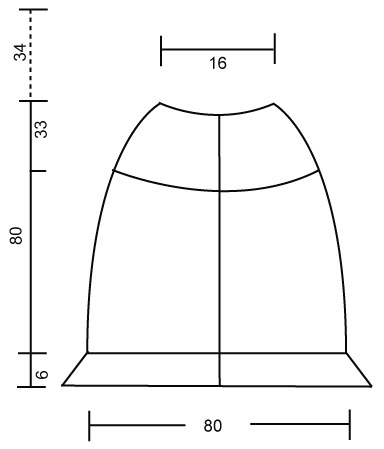
What can you do with our patterns? You can share DROPS patterns online, using the pattern original picture, materials, name and number. But you are NOT ALLOWED to reproduce the complete pattern digitally in any way. Yarn stores are welcome to use the DROPS pattern database to promote the sale of our assortment. You can print out our patterns, make as many copies as you’d like. The only thing we ask is that you don't make any changes / additions to the original printed document. And that the patterns according to the DROPS philosophy are given out to the consumers for free. Editorials that wish to publish our patterns in printed books or magazines can contact us for more information. The sale of garments based on DROPS patterns is permitted as long as they are sold as single items or per order. Further commercial use of the patterns is not permitted. It has to be clearly stated that the garment is made based on a design from DROPS DESIGN. The use of clothing labels of which DROPS DESIGN forms part is conditioned by the inclusion of the following text: “A DROPS DESIGN made by …..”. The use of DROPS photos for marketing purposes/sales is only permitted in connection with the use/sale of DROPS products. The photos may not be cut or edited and the logo should be clearly visible.
We reserve the right to withdraw the permission for use of our patterns at any time, notwithstanding the reason.
Each of our patterns has specific tutorial videos to help you.
These step-by-step tutorials might also help you:
Why is the knitting/crochet tension so important?
Knitting tension is what determines the final measurements of your work, and is usually measured per 10 x 10 cm. It is provided like so: number of stitches in width x number of rows in height - eg: 19 stitches x 26 rows = 10 x 10 cm.
The knitting tension is very individual; some people knit/crochet loosely while others work tightly. You adjust the knitting tension with the needle size, which is why the suggested needle size is only meant as a guide! You need to adjust this (up or down) to ensure that YOUR knitting tension matches the knitting tension provided in the pattern. If you work with a different knitting tension than provided you will have a different yarn consumption, and your work will have different measurements than what the pattern suggests.
The knitting tension also determines which yarns can replace each other. As long as you achieve the same knitting tension you can replace one yarn with another.
See DROPS lesson: How to measure your tension/gauge
See DROPS video: How to make a gauge tension swatch
How do I know how many balls of yarn I need?
The required amount of yarn is provided in grams, eg: 450 g. To calculate how many balls you’ll need you first need to know how many grams are in 1 ball (25g, 50g or 100g). This information is available if you click on the individual yarn quality on our pages. Divide the amount required with the amount of each ball. For example, if each ball is 50g (the most common amount), the calculation will be as follows: 450 / 50 = 9 balls.
Can I use a different yarn than what the pattern suggests?
The important thing when changing from one yarn to another is that the knitting/crochet tension remains the same. This is so that the measurements of the finished piece will be the same as on the sketch provided. It is easier to achieve the same knitting tension using yarns from the same yarn group. It is also possible to work with multiple strands of a thinner yarn to achieve the knitting tension of a thicker one. Please try our yarn converter. We recommend you to always work a test swatch.
Please NOTE: when changing yarn the garment might have a different look and feel to the garment in the photo, due to individual properties and qualities of each yarn.
See DROPS lesson: Can I use a different yarn than the one mentioned in the pattern?
What are the yarn groups?
All our yarns are categorised into yarn groups (from A to F) according to thickness and knitting tension – group A contains the thinnest yarns and group F the thickest. This makes it easier for you to find alternative yarns to our patterns, should you wish to switch yarn. All yarns within the same group have a similar knitting tension and can easily replace each other. However, different yarn qualities have different structures and properties which will give the finished work a unique look and feel.
How do I use the yarn calculator?
At the top of all our patterns you’ll find a link to our yarn calculator, which is a helpful tool should you wish to use a different yarn than suggested. By filling in the yarn quality you wish to replace, the amount (in your size) and number of strands, the calculator will present good alternative yarns with the same knitting tension. Additionally it will tell you how much you’ll require in the new qualities and whether you’ll need to work with multiple strands. Most skeins are 50g (some are 25g or 100g).
If the pattern is worked with multiple colours, every colour will have to be calculated separately. Similarly, if the pattern is worked with several strands of different yarns (for example 1 strand Alpaca and 1 strand Kid-Silk) you will have to find alternatives for each, individually.
Why do you show discontinued yarns in the patterns?
Since different yarns have different qualities and textures we have chosen to keep the original yarn in our patterns. However, you can easily find options among our available qualities by using our yarn calculator, or simply pick a yarn from the same yarn group.
It is possible that some retailers still have discontinued yarns in stock, or that someone has a few skeins at home that they would like to find patterns for.
The yarn calculator will provide both alternative yarn as well as required amount in the new quality.
What size should I knit?
If you think it's hard to decide what size to make, it can be a good idea to measure a garment you own already and like the size of. Then you can pick the size by comparing those measures with the ones available in the pattern's size chart.
You'll find the size chart at the bottom of the pattern.
See DROPS lesson: How to read size chart
Why do I get the wrong knitting tension with the suggested needle size?
The needle size provided in the pattern serves only as a guide, the important thing is to follow the knitting tension. And since knitting tension is very individual, you will have to adjust the needle size to ensure that YOUR tension is the same as in the pattern – maybe you’ll have to adjust 1, or even 2 needle sizes, up or down to achieve the correct tension. For this, we recommend that you work test swatches.
Should you work with a different knitting tension than the one provided, the measurements of the finished garment might deviate from the measurement sketch.
See DROPS lesson: How to measure your tension/gauge
See DROPS video: How to make a tension/gauge swatch
Why is the pattern worked top-down?
Working a garment top-down provides more flexibility and room for personal adjustment. For example it is easier to try the garment on while working, as well as making adjustments to length of yoke and shoulder caps.
The instructions are carefully explaining every step, in the correct order. Diagrams are adjusted to the knitting direction and are worked as usual.
How do I work according to a knitting diagram?
The diagram depicts all rows/rounds, and every stitch seen from the right side. It is read from bottom to top, from right to left. 1 square = 1 stitch.
When working back and forth, every other row is worked from the right side and every other row is worked from the wrong side. When working from the wrong side, the diagram will have to be worked reversed: from left to right, knit stitches are purled, purl stitches are knit etc.
When working in the round every round is worked from the right side and the diagram are worked from right to left on all rounds.
See DROPS lesson: How to read knitting diagrams
How do I work according to a crochet diagram?
The diagram depicts all rows/rounds, and every stitch seen from the right side. It is worked from bottom to top, from right to left.
When working back and forth every other row is worked from the right side: from right to left and every other row is worked from the wrong side: from left to right.
When working in the round, every row in the diagram are worked from the right side, from right to left.
When working a circular diagram you start in the middle and work your way outwards, counter clockwise, row by row.
The rows usually start with a given number of chain stitches (equivalent to the height of the following stitch), this will either be depicted in the diagram or explained in the pattern.
See DROPS lesson: How to read crochet diagrams
How do I work several diagrams simultaneously on the same row/round?
Instructions for working several diagrams after each other on the same row/round, will often be written like so: “work A.1, A.2, A.3 a total of 0-0-2-3-4 times". This means you work A.1 once, then A.2 is worked once, and A.3 is repeated (in width) the number of times provided for your size – in this case like so: S = 0 times, M = 0 times, L=2 times, XL= 3 times and XXL = 4 times.
The diagrams are worked as usual: begin with the first row in A.1, then work the first row in A.2 etc.
See DROPS lesson: How to read knitting diagrams
See DROPS lesson: How to read crochet diagrams
Why are the sleeves shorter in larger sizes?
The total width of the garment (from wrist-to-wrist) will be larger in the larger sizes, despite the actual sleeves being shorter. The larger sizes have longer sleeve caps and wider shoulders, so there will be a good fit in all sizes.
Where on the garment is the length measured?
The measurement sketch/schematic drawing provides information regarding the full length of the garment. If it’s a jumper or a jacket the length is measured from the highest point on the shoulder closest to the neckline, and straight down to the bottom of the garment. It is NOT measured from the tip of shoulder. Similarly, the length of yoke is measured from the highest point on the shoulder and down to where yoke is split into body and sleeves.
On a jacket measures are never taken along bands, unless specifically stated. Always measure inside band stitches when measuring the length.
See DROPS lesson: How to read a schematic drawing
What is a repeat?
Diagrams are often repeated on the round or in height. 1 repeat is the diagram the way it appears in the pattern. If it says to work 5 repeats of A.1 in the round, then you work A.1 a total of 5 times after/next to each other in the round. If it says to work 2 repeats of A.1 vertically/in height you work the entire diagram once, then begin again at the start and work the entire diagram one more time.
Why does the piece start with more chain stitches than it’s worked with?
Chain stitches are slightly narrower than other stitches and to avoid working the cast-on edge too tight, we simply chain more stitches to begin with. The stitch count will be adjusted on the following row to fit the pattern and measurement sketch.
Why increase before the rib edge when the piece is worked top-down?
The rib edge is more elastic and will contract slightly compared to, for example, stocking stitch. By increasing before the rib edge, you avoid a visible difference in width between the rib edge and the rest of the body.
Why increase in the cast-off edge?
It’s very easy to cast off too tightly, and by making yarn overs while casting off (and simultaneously casting these off) you avoid a too tight cast off edge.
See DROPS video: How to bind off with yarn overs (yo)
How do I increase/decrease on every 3rd and 4th row/round alternately?
To achieve an even increase (or decrease) you can increase on, for example: every 3rd and 4th row alternately, like so: work 2 rows and increase on the 3rd row, work 3 rows and increase on the 4th. Repeat this until the increase is complete.
See DROPS lesson: Increase or decrease 1 st on every 3rd and 4th row alternately
How can I work a jacket in the round instead of back and forth?
Should you prefer to work in the round instead of back and forth, you may of course adjust the pattern. You’ll need to add steeks mid-front (usually 5 stitches), and follow the instructions. When you would normally turn and work from the wrong side, simply work across the steek and continue in the round. At the end you’ll cut the piece open, pick up stitches to work bands, and cover the cut edges.
See DROPS video: How to knit steeks and cut open
Can I work a jumper back and forth instead of in the round?
Should you prefer to work back and forth instead of in the round, you may of course adjust the pattern so you work the pieces separately and then assemble them at the end. Divide the stitches for the body in 2, add 1 edge stitch in each side (for sewing) and work the front and back pieces separately.
See DROPS lesson: Can I adapt a pattern for circular needles into straight needles?
Why is the pattern slightly different than what I see in the photo?
Pattern repeats can vary slightly in the different sizes, in order to get the correct proportions. If you’re not working the exact same size as the garment in the photo, yours might deviate slightly. This has been carefully developed and adjusted so that the complete impression of the garment is the same in all sizes.
Make sure to follow instructions and diagrams for your size!
How do I make a women’s size garment into a men’s size one?
If you have found a pattern you like which is available in women’s size it’s not very difficult to convert it to men’s size. The biggest difference will be the length of sleeves and body. Start working on the women size that you think would fit across the chest. The additional length will be worked right before you cast off for the armhole/sleeve cap. If the pattern is worked top-down you can add the length right after the armhole or before the first decrease on sleeve.
Regarding additional yarn amount, this will depend on how much length you add, but it is better with a skein too many than too few.
How do I prevent a hairy garment from shedding?
All yarns will have excess fibres (from production) that might come off as lint or shedding. Brushed yarns (ie hairier yarns) have more of these loose, excess fibres, causing more shedding.
Shedding also depends on what is worn under or over the garment, and whether this pulls at the yarn fibres. It’s therefore not possible to guarantee that there will be no shedding
Below are some tips on how to get the best result when working with hairier yarns:
1. When the garment is finished (before you wash it) shake it vigorously so the looser hairs come off. NOTE: do NOT use a lint roller, brush or any method that pulls at the yarn.
2. Place the garment in a plastic bag and put it in your freezer - the temperature will cause the fibres to become less attached to each other, and excess fibres will come off easier.
3. Leave in the freezer for a few hours before taking it out and shaking it again.
4. Wash the garment according to the instructions on the yarn label.
Why does my garment pill?
Pilling is a natural process that happens to even the most exclusive of fibers. It's a natural sign of wear and tear that is hard to avoid, and that is most visible in high friction areas of your garment like a sweater's arms and cuffs.
You can make your garment look as new by removing the pilling, using a fabric comb or a pill/lint remover.
In the meantime, you can read the questions and answers that others have left to this pattern or join the DROPS Workshop on Facebook to get help from fellow knitters/crocheters!
You might also like...
Elven Dance |
|
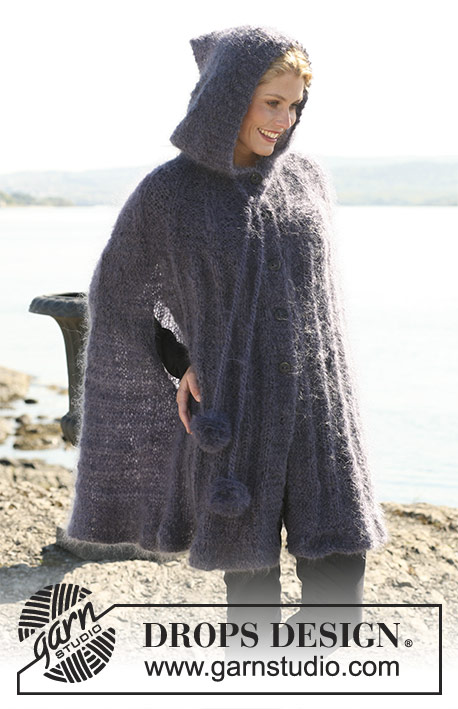 |
 |
DROPS cape with hood in ”Vienna” eller "Melody". Size M.
DROPS Extra 0-450 |
|
|
Garter st, back and forth on needle: K all rows. Decreasing tip: Dec 4 sts each side by dec 4 sts evenly on sts worked in Garter st pattern. Dec on rows from RS. Garter st pattern: Row 1: K from RS Row 2: P from WS Row 3: K from RS Row 4: P from WS Row 5: P from RS Row 6: K from WS Repeat row 1 to 6. Double moss st: Row 1: * K2, P2 *, repeat from *-* and finish with K2. Row 2: K over K and P over P. Row 3: P over K and K over P. Row 4: K over K and P over P. Repeat row 3 and 4. Buttonholes: Cast off for buttonholes on right front piece. 1 buttonhole = cast off 3rd front band st from mid front and cast on 1 new st on return row. Cast off for buttonholes when piece measures (measured from the first MT): 34, 43, 52, 61, 70 and 79 cm. Cape: Worked back and forth on circular needle from mid front. Cast on 325 sts (includes 6 front band sts each side towards mid front) on circular needle size 7 mm with Vienna or Melody. K 2 rows. Continue in stocking st with 6 front band sts each side in garter st. Remember the knitting tension! When piece measures 6 cm work next row as follows from RS: 6 front band sts in garter st, * K1, K2 tog *, repeat from *-* until 7 sts remain, K1, 6 front band sts in garter st = 221 sts. K 1 row from WS. Insert a Marking Thread (MT) and now measure piece from here. K 1 row from RS, at the same time dec 1 st after the 6 front band sts = 220 m. K from row from WS. Continue as follows from RS: 6 front band sts in garter st, K2, * P4, K2 *, repeat from *-* on the next 30 sts, Garter st pattern – see above - on the next 41 sts, K2, repeat from *-* on the next 60 sts, Garter st pattern on the next 41 sts, K2, repeat from *-* on the next 30 sts and finish with 6 front band sts in garter st. At the same time when piece measures 10 cm from MT dec 4 sts each side – see Decreasing tip! Repeat the dec on every 7 cm a total of 6 times. At the same time when piece measures 27 cm from MT (after 3 dec = 196 sts on row) continue as follows from RS: 6 front band sts in garter st, K2, * P4, K2 *, repeat from *-* on the next 30 sts, 6 garter sts, Garter st pattern on the next 23 sts, K2, repeat from *-* on the next 60 sts, Garter st pattern on the next 23 sts, 6 garter sts, K2, repeat from *-* on the next 30 sts and finish with 6 front band sts in garter st. When piece measures 29 cm from MT divide the piece as follows: keep the first 41 sts on needle and slip the remaining 155 sts on a stitch holder. Right front piece: Continue back and forth on needle on the 41 sts as follows: 6 front band sts in garter st, K2, * P4, K2 * repeat from *-* on the next 30 sts, 3 garter sts. Continue like this until piece measures 18 cm from where piece was divided. Note! Remember to cast off for buttonholes – see above. Slip the 41 sts on a stitch holder. Back piece: Slip the next 114 sts back on needle and work pattern as before back and forth on needle. Note! Remember dec at sides. Continue like this until piece measures 18 cm from where piece was divided (= 47 cm from MT). All dec are now complete = 90 sts. Slip the 90 sts on a stitch holder. Left front piece: Slip the last 41 sts back on needle and continue back on forth on needle as follows: 3 garter sts, * P4, K2 *, repeat from *-* on the next 30 sts, K2, 6 front band sts in garter st. Continue like this until piece measures 18 cm from where piece was divided. Yoke: Slip all sts back on needle = 172 m. Insert a MT and now measures piece from here. Continue as follows from RS: 6 front band sts in garter st, K2, * P4, K2 *, repeat from *-* on the next 30 sts, 6 garter sts, Garter st pattern on the next 11 sts, K2, repeat from *-* on the next 60 sts, m, Garter st pattern on the next 11 sts, 6 garter sts, K2, repeat from *-* on the next 30 sts and finish with 6 front band sts in garter st. Continue like this until piece measures 2 cm from MT. Continue as follows: 6 front band sts in garter st, K2, * P4, K2 *, repeat from *-* on the next 30 sts, Garter st pattern on the next 17 sts, K2, repeat from *-* over de next 60 sts, Garter st pattern on the next 17 sts, K2, repeat from *-* on the next 30 sts and finish with 6 front band sts in garter st. Continue like this until piece measures 7 cm from MT. K 1 row from RS on all sts at the same time dec 14 sts evenly = 158 sts. K 1 row from WS. K 1 row from RS, at the same time dec 14 sts evenly = 144 sts. K 1 row from WS. Now continue as follows: 6 front band sts, K2, * P8, K2 *, repeat from *-* on the next 130 sts and finish with 6 front band sts. When piece measures 11 cm from MT dec 1 st in each P section and repeat the dec on every 3.5 cm a total of 6 times = 66 sts. Continue with K over K and P over P (with front bands in garter st as before) until piece measures 31 cm from MT and now K 6 rows on all sts. Hood: K 1 rows from RS, at the same time inc 4 sts evenly = 70 sts. Insert a MT and now measure piece from here. Continue in Double moss st – see above – with 6 front band sts in garter st each side. Continue like this until hood measures approx 34 cm from MT and cast off loosely. Assembly: Sew tog hood at the top, edge to edge with neat sts. Sew on buttons. Twisted ribbon: Cut 4 threads measuring 3 meters each. Twist them until they resist, fold threads double and let them twist again. Tie a knot each end and thread the ribbon round neckline. Make 2 pompoms with a diameter of approx 8 cm and attach to the ends of ribbon. www.garnstudio.com |
|

|
|
|
Have you made this or any other of our designs? Tag your pictures in social media with #dropsdesign so we can see them! Do you need help with this pattern?You'll find tutorial videos, a Comments/Questions area and more by visiting the pattern on garnstudio.com. © 1982-2024 DROPS Design A/S. We reserve all rights. This document, including all its sub-sections, has copyrights. Read more about what you can do with our patterns at the bottom of each pattern on our site. |
|
With over 40 years in knitting and crochet design, DROPS Design offers one of the most extensive collections of free patterns on the internet - translated to 17 languages. As of today we count 304 catalogues and 11422 patterns - 11422 of which are translated into English (UK/cm).
We work hard to bring you the best knitting and crochet have to offer, inspiration and advice as well as great quality yarns at incredible prices! Would you like to use our patterns for other than personal use? You can read what you are allowed to do in the Copyright text at the bottom of all our patterns. Happy crafting!







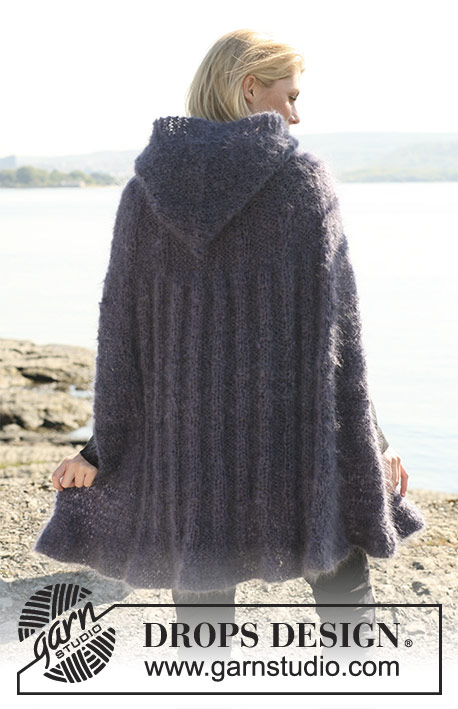

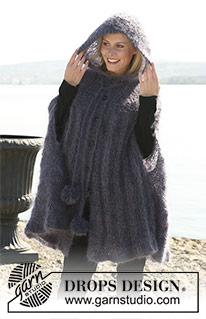
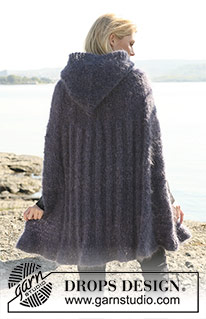
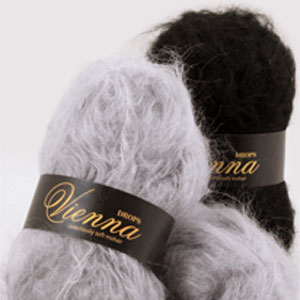


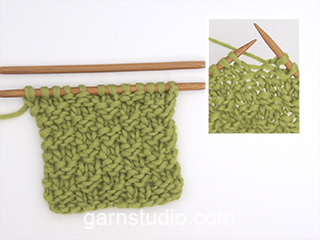
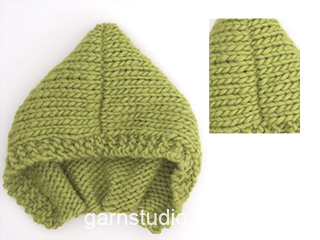


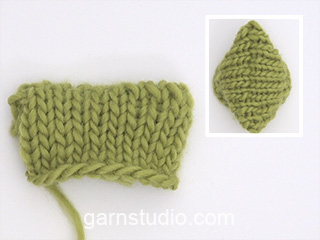















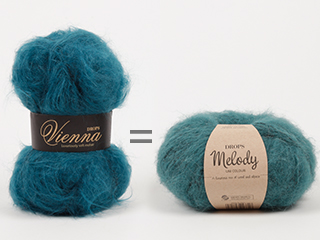






















Comments / Questions (18)
This pattern mentions both garter stitch and "garter stitch pattern". They don't appear to be the same. Are they? Thank you, Terri
25.06.2022 - 19:09DROPS Design answered:
Dear Terri, no, they are not the same. Normal garter stitch is knit all rows, working back and forth. The garter stitch pattern is explained at the beginning of the pattern instructions. Here, you combine knitted and purled rows, to make the space between ridges wider. Happy knitting!
26.06.2022 - 12:59Hvor mange meter garn må jeg beregne for denne oppskriften?
31.01.2022 - 12:57DROPS Design answered:
Hei Anne. Til denne må du bruke 350 gram DROPS Melody. 50 gram Melody = 140 meter. Så 350 gram = 7 nøster x 140 meter = 980 meter. Så da trenger du 980 meter garn til denne ponchoen. mvh DROPS Design
31.01.2022 - 15:02I noticed this is for a size medium. I woyl like to try to make it for a plus size. Do you have a modified pattern or suggestions?
22.09.2021 - 16:23DROPS Design answered:
Dear Nicole, please understand that we cannot modify our patterns to each individual request. However, please note that this is a cape, for which exact sizing is not that important. Furthermore, you might try to knit this with a thicker yarn, and / or with a bigger needle. (You might try adding a thin yarn, like kidsilk, or Alpaca silk, Alpaca,and use a bigger size needle. Or you can recalculate the stitch numbers. However, please always make a swatch and calculate the modifications accordingly. Happy Knitting!
22.09.2021 - 17:14Bonjour, sur le patron il est noté ce qui suit: Point mousse fantaisie – voir ci-dessus – sur les 41 m suivantes Mais sur les explications le point mousse fantaisie ce fait sur 6 rangs. Je suis un peu mélangé. Merci à l'avance pour votre réponse
07.11.2020 - 21:23DROPS Design answered:
Bonjour Sylvie, vous tricotez les 41 mailles suivantes en suivant le point mousse fantaisie autrement dit, ces mailles vont se tricoter comme indiqué sur 6 rangs, mais vous les tricotez au 1er rang à l'endroit (et les autres mailles comme indiqué), puis au 2ème rang, vous les tricoterez à l'envers etc... en même temps, tricotez les mailles en côtes, à l'endroit ou à l'envers comme indiqué.
09.11.2020 - 10:33I'm trying to work out this pattern with a smaller number of stitches because my yarn is making my gauge too wide, but I'm confused with the measurements in the diagram. If 13st = 10cm (as per gauge), then casting on 325st=250cm around the bottom. What does the 80cm along the bottom in the diagram refer to?
28.03.2020 - 18:16DROPS Design answered:
Dear Encarni, at the very bottom of the piece there is a small "ruffle", that is why you cast on more stitches and after 6 cm-s you will decrease a large number of stitches, and knit the cape from there. The 80 cm refers to the width after this ruffle (after the decrease). Happy Knitting!
29.03.2020 - 22:34Hi.... this pattern is a little messed up...directions for garter are actually stockinette... Then when at 10:5” it says 6 band sts , rib pattern, 6 garter sts followed by 23 garter sts ... This makes no sense ....
03.08.2019 - 16:08DROPS Design answered:
Dear Ki, when you work garter stitch back and forth you need to K all stitches on every row. When piece measures 10½'' you will work a small edge over holes for arms, that's why you will work some stitches in rib (K over K and P over P) and some other stitches in garter st (= K from RS as well as from WS). Happy knitting!
08.08.2019 - 10:44Was sind Blendem? Welche Maschen muss ich da stricken.
25.05.2019 - 12:39DROPS Design answered:
Liebe Petra, die "Blendem" sind hier die Blendemaschen. Viel Spaß beim stricken!
27.05.2019 - 13:20I understand the "Garter Pattern" and the *P4,K2* repeat (ribbing). On the RS after the 6 front band sts there is K2. What happens to these on the WS? Are they part of the ribbing and therefore P2. for Clarification Is this correct WS: 6 st band in garter st, p2, *k4, P2* 5X, 41sts Garter St Pattern, P2 …..
05.04.2019 - 19:05DROPS Design answered:
Dear Joan, yes, the pattern goes ths way - so on WS you knit P2 after band sts. Happy knitting!
05.04.2019 - 21:54Thank you so much for the fast response to my question. It makes perfect sense.🙂
04.04.2019 - 16:12This pattern’s main “body” has a RS row that is a variation of ..RS: 6 front band sts in garter st, K2, * P4, K2 *, repeat from *-* on the next 30 sts, Garter st pattern – see above - on the next 41 sts, K2, repeat from *-* on the next 60 sts, Garter st pattern on the next 41 sts, K2, repeat from *-* on the next 30 sts and finish with 6 front band sts in garter st.[variation because the # of stitches vary but the “pattern” is common]. What is the next WS row?
04.04.2019 - 15:09DROPS Design answered:
Dear Mrs Shirikian, from WS work the rib pattern with K over K and P over P (= the P4 from RS will be worked K4 from WS and the K2 from RS will be worked P2 from WS) and work the stitches from garter stitch pattern as explained at the beginning of the pattern (= row 1 = K from RS, row 2 = P from WS, row 3 = K from RS, row 4 = P from WS, Row 5 = P from RS and row 6 = K from WS). Happy knitting!
04.04.2019 - 15:52